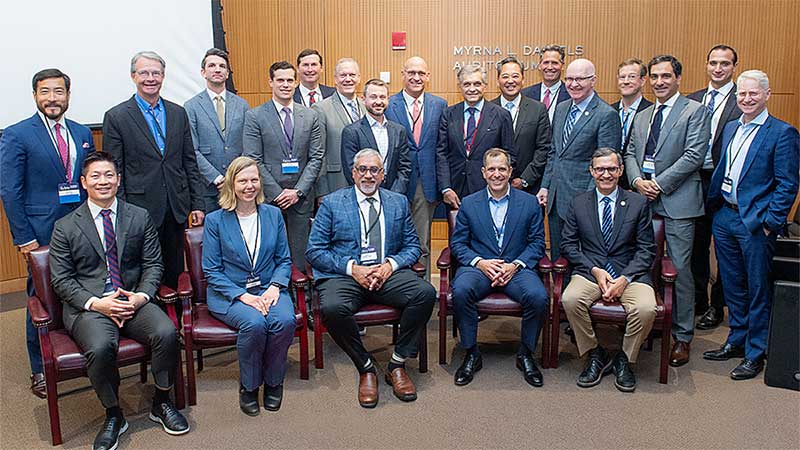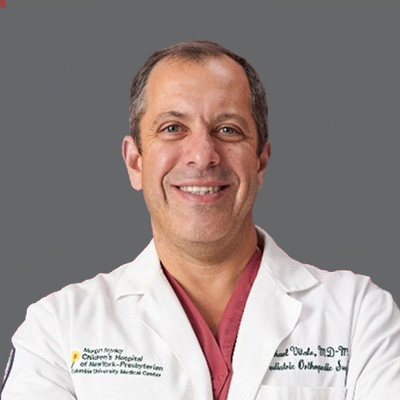Michael Vitale, MD, Chief of Pediatric Spine Surgery at NewYork-Presbyterian Morgan Stanley Children’s Hospital and Och Spine at NewYork-Presbyterian, has always made it his personal mission to improve safety and surgical outcomes. In 2012, he created the Safety in Spine Surgery Project, a nonprofit dedicated to developing and promoting ways to reduce risk of harm to patients before, during, and after spine surgery. Beyond standardizing guidelines, a core part of the organization’s work is hosting an annual summit that brings together providers, patients, and other stakeholders to discuss and promote systematic improvements and best practices to enhance spine surgery safety.
This past year, more than 150 pediatric and adult spine surgeons and other healthcare professionals from around the world attended the May 2024 event, which focused on how emerging technologies like robotics can improve care. The event was co-chaired by Lawrence Lenke, MD, Chief of Spinal Deformity Surgery and Co-Director and Surgeon-in-Chief of Och Spine at NewYork-Presbyterian and Columbia, and included presentations from NewYork-Presbyterian, Columbia and Weill Cornell Medicine physicians:
- Roger Härtl, MD, Co-Director and Neurosurgical Director at Och Spine at NewYork-Presbyterian and Weill Cornell Medicine
- Michael Virk, MD, PhD, a neurological spine surgeon at Och Spine at NewYork-Presbyterian and Weill Cornell Medicine
- Joseph Lombardi, MD, an orthopedic spine surgeon at Och Spine at NewYork-Presbyterian and Columbia
- Christopher Mandigo, MD, a neurological spine surgeon at Och Spine at NewYork-Presbyterian and Columbia
Attendees had the opportunity to learn from six best-in-class papers and nine scientific sessions. Stakeholders transparently shared both their successes and learnings with robotics, with the culmination of the event being the creation of best practice guidelines for the use of robotics in spine surgery.
Making Robotic Spine Surgery Safer
While robotics is being widely adopted across medical disciplines, there is no standardized approach to implementing the technology in spine surgery. “With most new technologies, in the beginning there is usually more enthusiasm and less full appreciation of the true outcomes,” says Dr. Vitale. “That's been the case for robotic spine surgery. We've all been aware of a number of cases, situations, stories, and papers that are being written about safety problems, largely neurological, related to robotic spine surgery.”

The speakers from the 2024 Safety in Spine Surgery Summit
Understanding that a universal approach could help neurological and orthopedic spine surgeons prevent safety issues, Dr. Vitale worked with experts leading up to the summit to draft best practice guidelines for robotics. At the end of the summit, attendees participated in a Delphi process to gain consensus on the final guidelines. “We were left with 55 practice guidelines that provide the promise of standardizing the field and will help surgeons avoid the mistakes,” says Dr. Vitale.
Preventing harm before it occurs is the crux of the Annual Safety in Spine Surgery Summit. Previous best practice guidelines and checklists developed from this event include:
- Adolescent idiopathic scoliosis bracing
- Use of halo gravity traction for pediatric spinal deformity
- Prevention of wrong level surgery in spinal deformity
- Surgical site infection (SSI) prevention with surgical treatment of early-onset scoliosis
- Response to intraoperative neuromonitoring (IONM) changes in patients with a stable spine
- Response to IONM events in high-risk spinal deformity surgery
- Recommendations to prevent, diagnose, and treat SSI in high-risk pediatric spine surgery
The new best practice guidelines for robotics in spine surgery are currently in the final stage of the vetting process, where they will be reviewed by robotics industry professionals, before being published publicly this summer. “I think that these new best practices will make robotic spine surgery safer, especially for new programs, and have a real-world impact on upstream patients,” says Dr. Vitale.
I think that these new best practices will make robotic spine surgery safer, especially for new programs, and have a real-world impact on upstream patients.
— Dr. Michael Vitale
Key Takeaways
Dr. Vitale hopes this year’s attendees walk away with a lot of actionable insights to bring back to their practice, such as the importance of taking a systems approach to spine surgery and adopting new technology at an appropriate, evidence-based pace.
Outside of discussing clinical progress, a keynote address delivered by leadership consultant Nick Petrie about physician well-being and resiliency was one of the most impactful sessions of the event. “There was unbelievable enthusiasm for his message, which was understanding the difference between pressure and stress, and then understanding that the coping mechanisms people use may vary,” says Dr. Vitale. “We’re all under pressure, but we don’t need to react to it. There are ways to manage pressure so that it doesn’t have to create such negative stress, because in a field like spine surgery the stakes are already high.”
As work for next year’s summit begins with discussion on which best practice guidelines to tackle next, Dr. Vitale expressed appreciation for all those who were involved in this year’s event. “I'm really grateful and appreciative of this best-in-class group of spine surgeons for sharing their expertise and experience,” he says.



